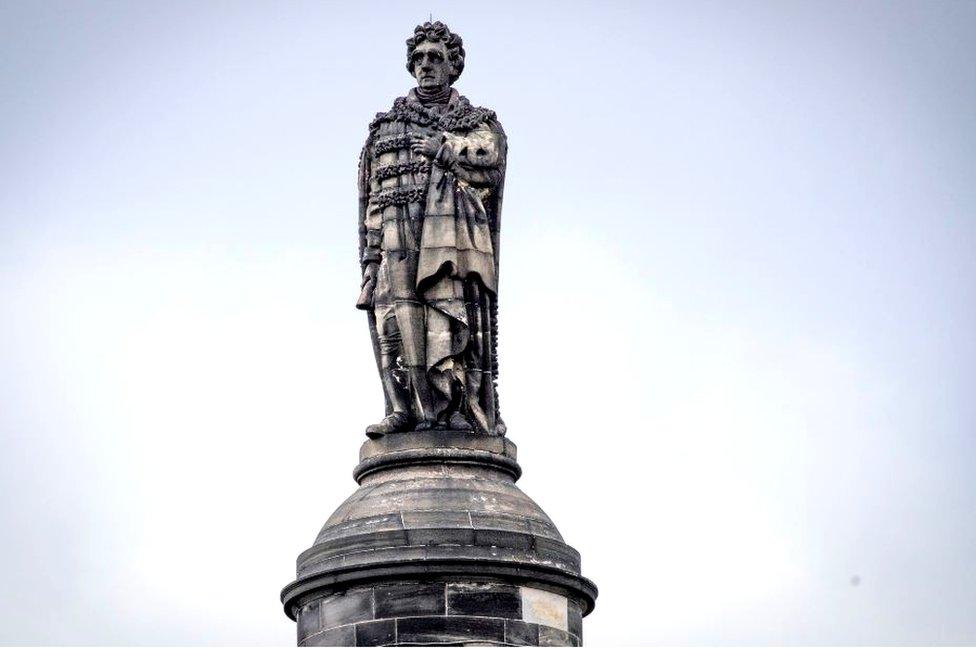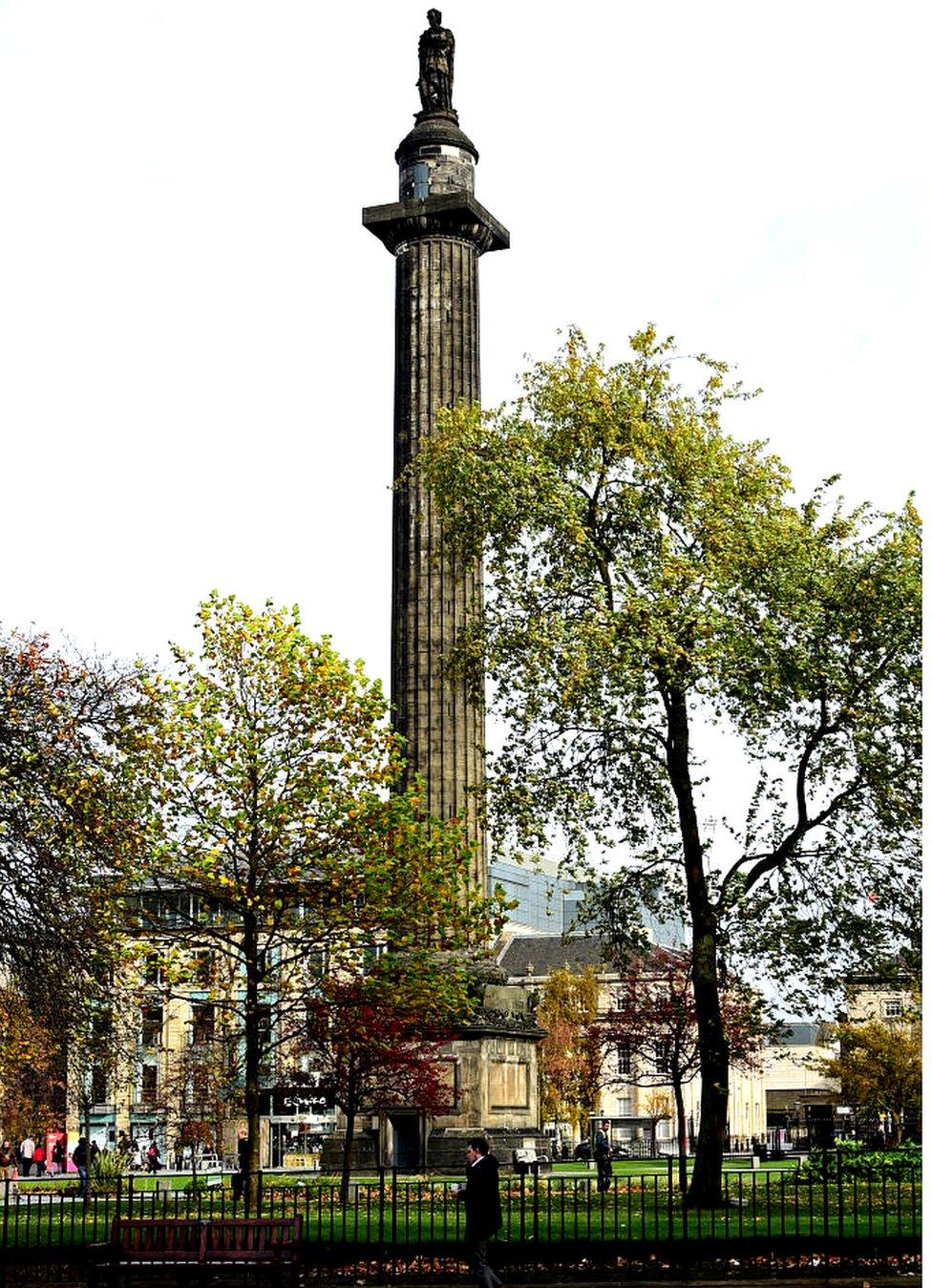Plans approved to remove slavery plaque from Edinburgh statue
- Published

A plaque stating that Henry Dundas was instrumental in deferring the abolition of the slave trade was described as "cartoonishly inaccurate" by his descendants
A plaque detailing links to slavery could be removed from a famous Edinburgh monument.
The Melville Monument in St Andrew Square Garden was erected in 1827 to honour Henry Dundas, the first Viscount Melville.
But in 2021, following demonstrations from the Black Lives Matter movement, the statue was dedicated to those enslaved because of his actions.
Plans have now been approved to remove the plaque.
Council planning officials said removing the A3-sized brass plaque would "preserve the character and appearance of the conservation area."
The U-turn follows a campaign by descendants of Henry Dundas who disagreed with the wording of the plaque, which said that Dundas was "instrumental in deferring the abolition of the Atlantic slave trade".
It read: "Slave trading by British ships was not abolished until 1807. As a result of this delay, more than half a million enslaved Africans crossed the Atlantic. "
A group which includes members of the Dundas family said the plaque's wording was "cartoonishly inaccurate" and was "hurtful to our family."
They lodged a planning application with the City of Edinburgh Council which was approved by councillors on Wednesday.
However, they need to get the go-ahead from owners of the buildings around St Andrew Square - who have ownership of the monument - before the plaque can be taken down.

Who was Henry Dundas?
According to National Records of Scotland, Henry Dundas was known as the "uncrowned king of Scotland" and "Harry the ninth" due to the extent of his political power.
He entered the Faculty of Advocates in 1763 and became MP for Midlothian from 1774.
He was the trusted lieutenant of British Prime Minister William Pitt and the most powerful politician in Scotland in the late 18th century.

Dundas was born on the Royal Mile in 1742
He was a controversial figure during his own lifetime, a defender of the British Empire and its expansion.
While home secretary in 1792 and first secretary of state for war in 1796 he was said to be instrumental in deferring the abolition of the Atlantic slave trade.
Slave trading by British ships was not abolished until 1807.
However his descendants and supporters say he was an abolitionist, making sure the process was gradual so it would get through legislation and became law.

Chas Booth, Edinburgh Greens spokesperson on planning, said there were no valid planning reasons to refuse the application to remove the plaque.
He said: "The planning system cannot take a view on the wording of the plaque, and only looks at the preservation of the historic structure.
"This decision does not mean the plaque will be removed, nor should it be.
"The wording of this plaque was agreed by all progressive parties on the council in 2020. That decision should be respected, not reversed."
'Attempt to whitewash'
Mr Booth described the move by the Melville Monument Committee, which is led by Bobby Dundas, a direct descendant of the first Viscount Melville, as an "attempt to whitewash."
He added: "It is vital that the city acknowledges and addresses our role in slavery and racism in our colonial past."
The wording of the plaque was agreed in 2020 by city councillors, heritage experts and Professor Sir Geoff Palmer, who led a review of Edinburgh's links with slavery and colonialism.

A brass plate was added to the structure in 2021 to detail links to slavery

Planning permission to add it to the monument's base was granted the following year and proprietors also approved the change.
Since then Mr Dundas has publicly defended his ancestor's record as a "politician of vision and integrity" who had "no personal involvement in the slave trade."
He is also chair of the Henry Dundas Committee for Public Education on Historic Scotland.
A spokeswoman for the committee said it was "very relieved" by the council's decision as the plaque was "cartoonishly inaccurate" and that "even the most anti-Dundas historians do not hold him responsible for the trafficking of more than 500,000 Africans and a 15-year delay in abolition."
She added: "It was unfair to the public and hurtful to our family for it to remain in place.
"The plaque never should have been fixed directly onto the monument. The city leases the square. It doesn't own it or the monument. It was not the city's monument to deface and damage, with bolts piercing the outer surface to attach a metal plate. It was obviously the right decision to remove it.
"Henry Dundas was a remarkable politician for many reasons, some of which would surprise his modern critics.
"Few people know, for example, that he convinced King George III to fire the governor of the Cape, George Yonge, for engaging in an illegal scheme to smuggle slaves, or that he blocked a plan to send Christian missionaries to convert and 'civilize' the people of India.
"Even fewer seem to know that he appointed an abolitionist to be Upper Canada's first lieutenant-governor, with the result that Upper Canada became the first territory in the British Empire to abolish slavery. A plaque that was fair and balanced would recognize such facts."
Reporting by local democracy reporter Donald Turvill